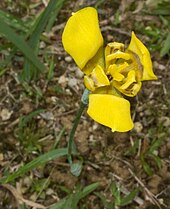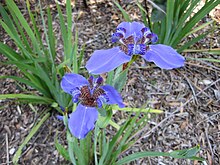pt-BR
nomes no trilho de navegação




Trimezia is a genus of flowering plants in the family Iridaceae, native to the warmer parts of southern Mexico, Central America, South America, Florida, and the West Indies.[2] Trimezia is placed in the tribe Trimezieae. The division of the tribe into genera has varied considerably. In one approach, it contains only the genus Trimezia, which then includes the genera Neomarica, Pseudotrimezia and Pseudiris. In other approaches, two to five genera are recognized, sometimes also including the genus Deluciris.
The English names walking iris, apostle's iris and apostle plant have been used for many species, regardless of the generic placement (e.g. for Trimezia gracilis, syn. Neomarica gracilis). New plantlets form at the end of the flower spikes; after flowering, the spikes fall over and a new plant grows, so the plant "walks". Names including "apostle" refer to the incorrect belief that plants do not flower until 12 or more leaves are present.[3]
The rootstock is variously described as an elongated corm or a rhizome. Plants vary in height from about 7 cm (2.8 in) in the case of T. pusilla to 1.6 m (5.2 ft) in the case of T. spathata subsp. sincorana. Linear to lanceolate leaves grow from the base of the plant. Most species have flowers in some shade of yellow. The six tepals are arranged in two series. The outer tepals (sepals) are larger than the inner ones (petals); both may have brown-purple markings at the base. The stamens have free filaments (i.e. they not fused together or fused to the style). The style is divided into three branches, each of which usually has two lobes.[4]
The genus Trimezia was first published with an appropriate description by William Herbert in 1844.[5] Herbert attributed the name to Salisbury, whose use he described as "absque charactere" ('without character').[6] The genus name is derived from the Greek words tri, meaning "three", and meze, meaning "greater".[7]
Trimezia is placed in the tribe Trimezieae of the subfamily Iridoideae.[8] The number of genera into which the tribe is divided has varied considerably. Three genera were used before 2008: Trimezia, Neomarica and Pseudotrimezia. Some sources used all three; others combined Trimezia and Neomarica but retained Pseudotrimezia.[8] A further genus, Pseudiris, was published in 2008. Molecular phylogenetic studies have shown that although the tribe is monophyletic, the genera as traditionally used, based on morphological characteristics, are not. Three of the four main clades found in these analyses combine species from more than one genus.[9][8] One response to these findings, adopted as of May 2019 by Plants of the World Online and the World Checklist of Selected Plant Families, is to combine genera; thus Neomarica, Pseudiris and Pseudotrimezia are all placed within Trimezia.[1] An alternative approach, retaining the traditional genera but with changed circumscriptions, was put forward in 2018; an additional new genus, Deluciris, was also created within the tribe.[8]
When Trimezia was distinguished from Neomarica prior to molecular phylogenetic studies, i.e. entirely on morphological grounds, some vegetative characters were considered diagnostic. Trimezia in this sense always grows from corms, Neomarica almost always from rhizomes. Trimezia has flowering stems (scapes) that are circular in cross-section, whereas Neomarica has flattened scapes.[10] Lovo et al. (2018) consider these characteristics to be among those distinguishing their circumscription of Neomarica from the other genera into which they divide the tribe.[8]


As of May 2019, the World Checklist of Selected Plant Families accepted about 80 species of Trimezia.[11] However, this includes species that other sources place in different genera in the tribe Trimezieae. The placement in Lovo et al. (2018), where given in their paper, is shown in the second column.
Some former species which are now regarded as synonyms include:[11]
The genus is native to the warmer parts of southern Mexico, Central America, South America, Florida, and parts of the West Indies.[1] Trimezia species typically grow in damp grassland.[12]
 T. fosteriana
T. fosteriana  Flower of T. juncifolia
Flower of T. juncifolia  Flower of T. martinicensis, naturalized in Malaysia
Flower of T. martinicensis, naturalized in Malaysia Trimezia is a genus of flowering plants in the family Iridaceae, native to the warmer parts of southern Mexico, Central America, South America, Florida, and the West Indies. Trimezia is placed in the tribe Trimezieae. The division of the tribe into genera has varied considerably. In one approach, it contains only the genus Trimezia, which then includes the genera Neomarica, Pseudotrimezia and Pseudiris. In other approaches, two to five genera are recognized, sometimes also including the genus Deluciris.
The English names walking iris, apostle's iris and apostle plant have been used for many species, regardless of the generic placement (e.g. for Trimezia gracilis, syn. Neomarica gracilis). New plantlets form at the end of the flower spikes; after flowering, the spikes fall over and a new plant grows, so the plant "walks". Names including "apostle" refer to the incorrect belief that plants do not flower until 12 or more leaves are present.
Trimezia es un género de plantas herbáceas, perennes, bulbosas perteneciente a la familia Iridaceae. Las especies del género son oriundas de las regiones más cálidas de América Central, América del Sur y las Antillas. Comprende alrededor de 40 especies. Las plantas nacen de rizomas cortos, presentan un abanico de hojas parecidas a la de los lirios (Iris) y flores efímeras similares a Cypella, con tres segmentos externos más grandes y los tres internos pequeños. La mayoría de las especies tienen flores de color amarillo, con manchas marrones o púrpuras en el centro. En general las especies del género crecen durante el verano y tienen un período de reposo en el invierno. Un género afín es Neomarica, Sprague con el que muchas veces se lo confunde.
Las especies aceptadas para Trimezia y su publicación válida son las siguientes:
Trimezia es un género de plantas herbáceas, perennes, bulbosas perteneciente a la familia Iridaceae. Las especies del género son oriundas de las regiones más cálidas de América Central, América del Sur y las Antillas. Comprende alrededor de 40 especies. Las plantas nacen de rizomas cortos, presentan un abanico de hojas parecidas a la de los lirios (Iris) y flores efímeras similares a Cypella, con tres segmentos externos más grandes y los tres internos pequeños. La mayoría de las especies tienen flores de color amarillo, con manchas marrones o púrpuras en el centro. En general las especies del género crecen durante el verano y tienen un período de reposo en el invierno. Un género afín es Neomarica, Sprague con el que muchas veces se lo confunde.
Trimezia est un genre appartenant à la famille des Iridaceae. Il comprend une quarantaine d'espèces originaires des régions les plus chaudes de l'Amérique du Sud, l'Amérique centrale et des Antilles.
Les plantes proviennent de rhizomes courts, ont un bouquet de feuilles en éventail comme les Iris et des fleurs éphémères similaires à celles des Cypella, avec trois grands tépales externes et trois internes petits. La plupart des espèces ont des fleurs jaunes avec des taches brunes ou violettes au centre. En général, les espèces de ce genre se développent pendant l'été et ont une période de repos en hiver.
Vers la fin du XXe siècle, les analyses phylogénétiques conduisent à distinguer parmi les Iridacées la tribu des Trimezieae, qui inclut les Trimezia et les genres connexes que sont Pseudotrimezia est Neomarica, souvent confondus. En 2018, les recherches sont toujours en cours pour déterminer les espèces et leur affectation dans ces différents genres[2].
Selon ITIS :
Trimezia est un genre appartenant à la famille des Iridaceae. Il comprend une quarantaine d'espèces originaires des régions les plus chaudes de l'Amérique du Sud, l'Amérique centrale et des Antilles.
Les plantes proviennent de rhizomes courts, ont un bouquet de feuilles en éventail comme les Iris et des fleurs éphémères similaires à celles des Cypella, avec trois grands tépales externes et trois internes petits. La plupart des espèces ont des fleurs jaunes avec des taches brunes ou violettes au centre. En général, les espèces de ce genre se développent pendant l'été et ont une période de repos en hiver.
Vers la fin du XXe siècle, les analyses phylogénétiques conduisent à distinguer parmi les Iridacées la tribu des Trimezieae, qui inclut les Trimezia et les genres connexes que sont Pseudotrimezia est Neomarica, souvent confondus. En 2018, les recherches sont toujours en cours pour déterminer les espèces et leur affectation dans ces différents genres.
Trimezia é um género de plantas com flor pertencente à família Iridaceae,[1] que agrupa cerca de 80 espécies, com distribuição natural desde as Pequenas Antilhas até às regiões tropicais da América do Sul.
O World Checklist of Selected Plant Families aceita como válidas cerca de 80 espécies de Trimezia.[2] No entanto, a listagem que se segue inclui espécies que outras fontes colocam em géneros diferentes da tribo Trimezieae. A colocação em Lovo et al. (2018), quando fornecida no seu artigo, é mostrado na segunda coluna.
LovoWinkGilAmar18
Trimezia é um género de plantas com flor pertencente à família Iridaceae, que agrupa cerca de 80 espécies, com distribuição natural desde as Pequenas Antilhas até às regiões tropicais da América do Sul.